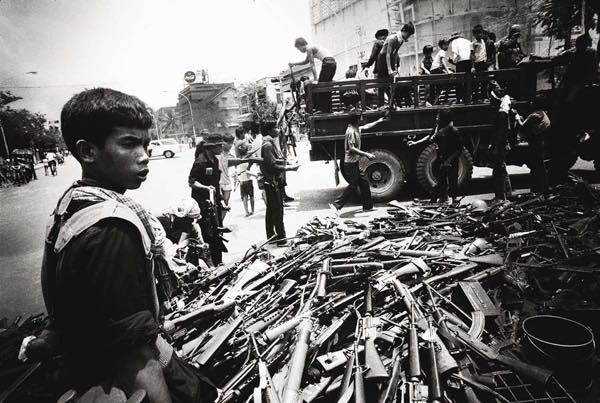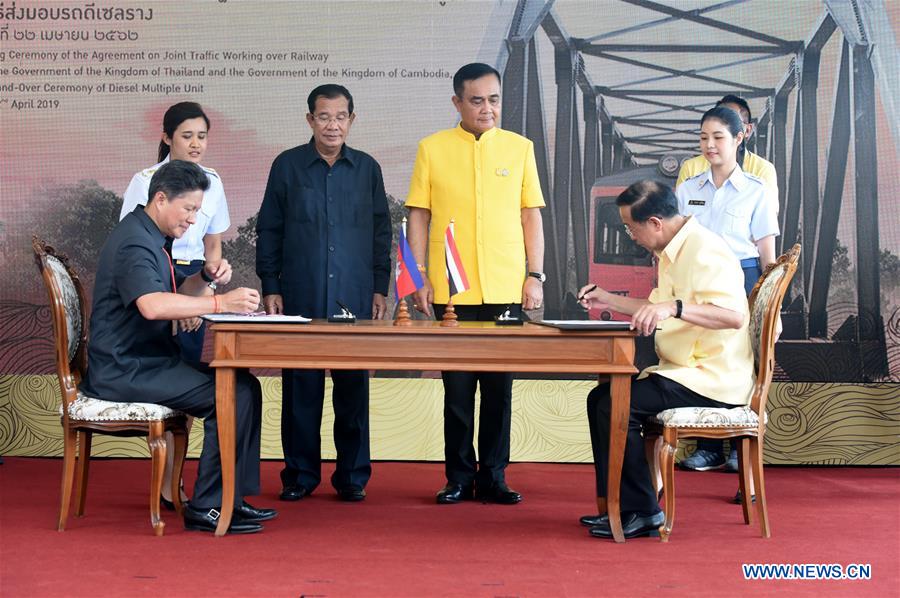On 16 April, 1975, a morning Cabinet meeting was devoted to sending a peace offer to Sihanouk in Peking as quickly as possible. Long Boret drafted the offer calling for an immediate ceasefire and a transfer of power to FUNK. The offer was sent to Peking via the Red Cross and the Agence France-Presse. The military situation was becoming worse, the Shell oil depot north of the city was set ablaze by gunfire, while fire swept shacks to the south of the city. All afternoon the Cabinet waited for the answer from Peking. By 23:00 an answer had still not arrived and the Cabinet realized that the Khmer Rouge did not want to accept the offer. Meanwhile, the Khmer Rouge had occupied the east bank of the Mekong following the withdrawal of the Parachute Brigade, while General Dien Del’s 2nd Division held the Monivong Bridge.
KAF T-28Ds flew their last combat sortie by bombing their own control centre and hangars at Pochentong after its capture by the Khmer Rouge. After virtually expending their ordnance reserves, 97 KAF aircraft escaped from airbases and auxiliary airfields throughout Cambodia, with a small number of civilian dependents on board, to safe havens in Thailand.
On April 16, 1975, according to his biography, long-serving Cambodian Prime Minister Hun Sen was wounded in the left eye while fighting for the Khmer Rouge.
Around April 16, 1976, (date uncertain) China’s Vice-Premier Zhang Chungqiao, one Mao’s ultra-radical ‘Gang of Four’paid a secret visit to Phnom-Penh. He was arrested in October 1976, following the death of Mao, and sentenced to death- later commuted to life imprisonment. He was released in 1998 and died in obscurity on April 21, 2008.
On April 17, 1970, South Vietnam offered to create a commission to study the repatriation of the Vietnamese residents of Cambodia to South Vietnam. On the 17th and 18th in Takeo, Vietnamese held in a detention camp were massacred. Survivors, including children, were left without care nor food, when they were not killed with edged weapons. In other places, army exactions happened alongside pillage and rape.
The army’s spokesperson said that the Vietnamese, who disappeared, were the victim of the spontaneous reaction of the Khmer people.
On 17 April 1975, the Khmer Rouge captured Phnom Penh and ended the civil war. Pockets of resistance remained, but the Khmer communists were now in control- beginning one of the darkest chapters in post-war 20th century history.

On April 18, 1954, Norodom Sihanouk resigned from his 4th stint as Prime Minister. He was replaced by Samdech Penn Nouth (for the 3rd time).
On April 18, 1975, following the announcement of the fall of Phnom Penh to Khmer Rouge forces. A Khmer Rouge radio station announced that most of the top leaders of the former Phnom Penh government had been beheaded. The radio broadcast, monitored in Bangkok, also indicated fighting was continuing in Cambodia’s provinces. Groups of refugees- many of them Cham Muslims attempt to cross the border into Thailand.
On April 19, 1960, Pho Proeung, who resigned as a member of the Council of Regency, formed a government as prime minister
On April 19, 1975, two days after the fall of Phnom Penh, the new Khmer Rouge regime announced that all former government employees, including soldiers, military officers, and policemen, would be required to register with the new local authorities. Those who complied with the order were told that they would be sent for “reeducation” at a camp in Battambang on April 28. This would be the start of the Cambodian genocide.
On April 20, 1970, Lon Nol again requested military assistance from the USA.
On April 21, 1954, a meeting was attended by the Thai Minister, British, Japanese and American Charges. A cable to the US Secretary of state read: Cambodian officials present were Prime Minister, Minister Defense, Foreign Minister Tep Phan, Information Minister Pho Proeung and Chief Protocol Monissara. General Tioulong stated military situation had deteriorated badly as Viet Minh increase pressure in all sectors. Deployment three battalions to critical northeast area at suggestion French command has completely denuded south and center of country. By concerted effort, Tioulong estimated Viet Minh could take over country in one week since royal army strength is spread so thin that it cannot halt major concentrated enemy effort. Phnom Penh is now defended by only two companies and six armored cars. French have told Cambodia not to rely on any substantial French assistance in troops since French command in south Vietnam has none to spare. Tioulong pointed out vulnerability of road between Kratie and Stung Treng (Route Nationale 31) to attack by Viet Minh battalions invading northeastern Cambodia. In event road is cut, Stung Treng will only be accessible by air, and several battalions would be isolated there.
Tioulong made plea for immediate material help from friendly countries. He said Cambodia has manpower and will to fight Communist invaders, but it lacks arms and material means.
Prime Minister Penn Nouth endorsed plea for arms, adding that all of his previous requests to visiting American legislators and statesmen, including Vice President Nixon, had been to no avail. He also mentioned that King’s request to Ambassador Heath for a few obsolete airplanes had gone unheeded. In light of this attitude, he did not understand how great powers expected Cambodia to hold out against invasion of foreign aggressor.
Cambodia, said Prime Minister, is on brink of disaster. Foreign military assistance given by France has always been predicated on containing Viet Minh within Cambodia, but never on crushing them. Now that two elite Viet Minh battalions have penetrated into Cambodia, and threaten Mekong valley, balance of power has shifted to Viet Minh, and in eyes of Prime Minister, fate of Cambodia could be settled in matter of days. FULL CABLE HERE
On April 21, 1956, the Chinese government provided economic assistance to the Cambodian government. The USA would cut aid to Cambodia a few days later.
On April 21, 1970, an unknown number of Vietnamese civilians were killed and wounded in Saang, 35 kilometres south of Phnom-Penh. Approximately sixty Vietnamese including women and children were grouped in a textile factory. They were taken to the entry of the village and forced to march carrying a white flag. The Vietcong would have fired at them and the Cambodian army too. A Vietnamese attack had started the previous day and Saang fell in the morning. The incident is mostly likely to General Sosthene Fenandez, as the same story is recounted (without the exact location) in an a previous article.
No more massacres were reported after this date. The camps, allegedly built to protect the Vietnamese, remained.
On April 22, 2019, the railway lines between Cambodia and Thailand were officially reconnected on Monday after a 45-year hiatus.
Cambodian Prime Minister Samdech Techo Hun Sen and Thai Prime Minister Prayut Chan-o-cha presided over the ceremony reconnecting both railway networks between Poipet town railway station in Banteay Meanchey province and Ban Khlong Luek railway station in Aranyaprathet district in east Thailand’s Sa Kaeo Province.

Cover photo: SJOBERG
